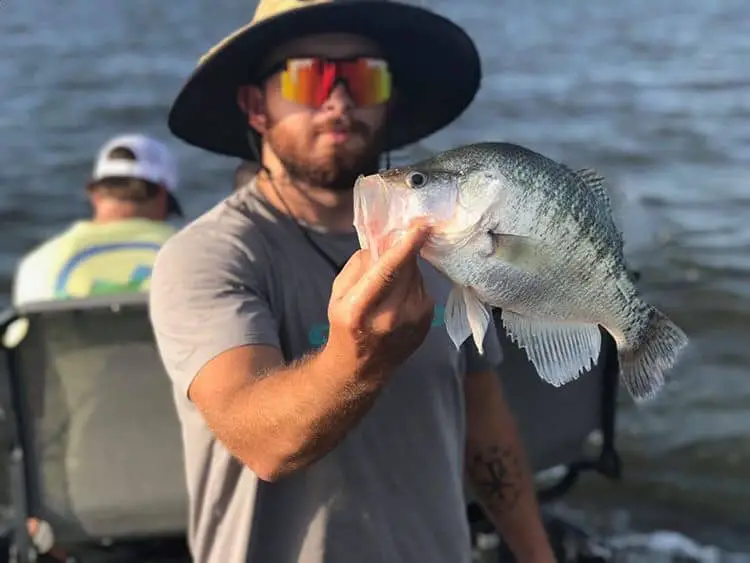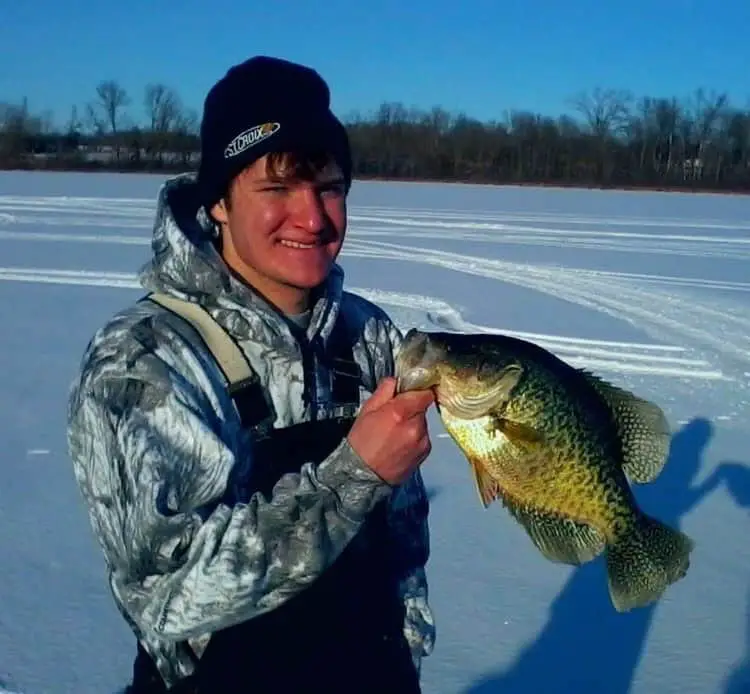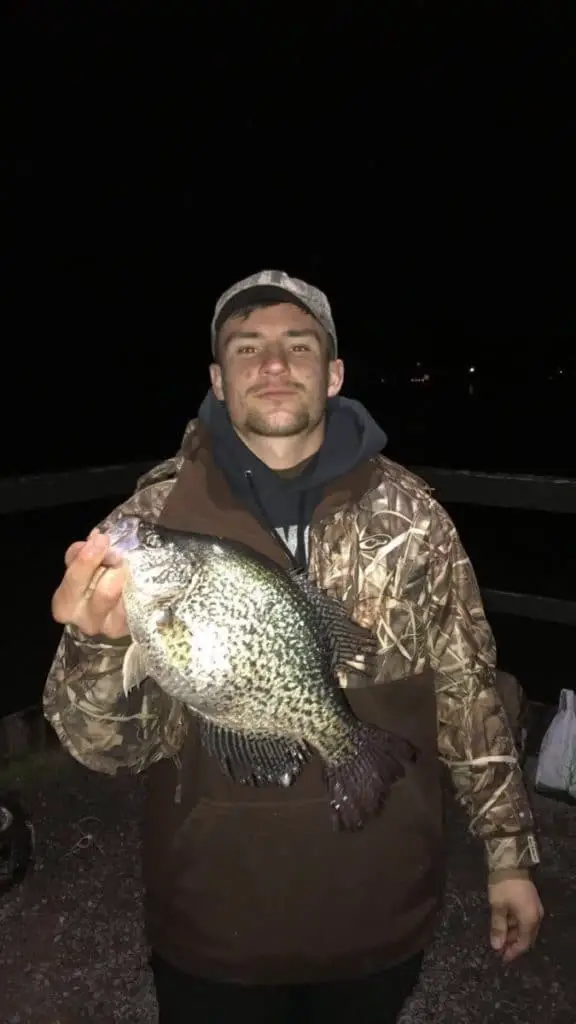Crappie are one of the most popular freshwater fish in the country. The main two species of crappie are the black crappie and the white crappie. They are distinguishable by their color and pattern. While the black crappie has a beautiful pattern of black dots on its sides that are in a sporatic pattern, the white crappies pattern tends to have verticle stripes.

We are going to be discussing the crappie habitat today. We will explore the two fish together and then separately. The males, from both crappie species, turn black during spawning. They also lose all markings at other times of the year. Water clarity, forage, and other factors will define their habitat.
In different bodies of water, in different parts of the country, their diets can be a little varied. Generally the black crappie prefer clear water, more shade and heavy forage. White crappie can be found suspended in open water, but tolerate muddy/murky water better than black crappie. The diet of black crappie consists of insects, crawfish, and worms. White crappie prefer shad and minnows.

Crappie were originally stream fish in Oklahoma, but are now found all over the country. Both species do best in lakes over 500 acres. Neither species do well on farm ponds because it will be over populated, quickly. White crappie, also known as goldring or silver perch, has a silvery color with brown or green shades on its back. They also have a white belly. The white crappie normally does not get over 2 pounds and they usually live 2 to 7 years. As an adult they measure in between 9 and 10 inches. The current world record for white crappie is 5.2 pounds.
White crappie can be found in reservoirs, lakes and large rivers. As stated earlier, they are more suited for the murky waters. If there is very little forage, the white crappie population will be larger than the black crappie. In lakes and reservoirs larger than 5 acres, white crappie are abundant. In the mornings and the evenings they are found in open water. During the day you can find them in quiet, shallow water (6-12 feet deep) and will be surrounded by structure.
White crappie are found in or near the Hudson Bay, Great Lakes, and the Mississippi River basins. This expands from New York and south Ontario west to South Dakota and down south to Texas. They flourish in waters that are warm with more silt than the black crappie. If white crappie are living in a river, they are going to be found in areas with no or very slow current. Examples are; backwaters, oxbows, and sloughs. When they spawn they deposit their eggs in poorly made nests in shallow water or on plants.
When you are out fishing for white crappie, focus in/on areas with a lot of structure. Rock piles, stumps, fallen trees, and shallow coves. Look for hanging rocks, sunken logs, and natural coverlets. This will protect them from preying fish.

Black crappie have laterally compressed body and are usually silver-gray or green in color. The black crappie is normally 4 to 8 inches long and has dark spots all over its body. The maximum black crappie length is 19 inches and the published maximum weight is just under 6 pounds.
Black crappie habitat includes reservoirs, lakes, navigation pools in large rivers, and borrow pits. They prefer little to no current, abundance of forage and/or submerged timber, and clear water. You can also find them in ponds, streams, sloughs, and lakes. As the white crappie, black crappie can be found in the Mississippi River Basins, the Great Lakes, and the St. Lawrence River.
Black crappie will form schools in clear water, over mud/sand, among vegetation. The native range for the black crappie; Virginia to Florida long the the Atlantic coast and southwest along Gulf of Mexico. In the spring, just before spawning season, you will find black crappie building nests by clearing gravel, mud, or sand from the bottom of the water so that females can lay their eggs. The male black crappie will guard the nest for 5 days or until the juveniles begin to emerge from the eggs.
The black crappie has many more nicknames than the white crappie; calico bass, crappie, grass bass, speck, speckled bass, and a few more. When black crappie are feeding, spawning, or if it is winter season you will find them in shallow water. Any other timeS they will be in deeper water, hiding from their prey.
A team of scientists tracked crappies that live in he Kentucky Lake, a huge reservoir on the Tennessee River. They compared the habitat of both the black crappie and the white crappie as they observed them living in one body of water. Here are some of their findings.
Fishing Lake Morena For Crappie? Discover what bait to use.
During pre-spawn both species were observed on flats that were adjacent to channels (both primary & secondary). They noticed that white crappie were located on deeper flats than the black crappie; normally 10 feet or deeper. The next most used habitat was river channels, both deep and shallow. Their population was made up of 33 percent white crappie and 43 percent black crappie.
When actual spawning season arrived both species of crappie changed habitat. They went from the deeper water to flats that were less than 8 feet deep. Flooded shoreline brush was preferred by the black crappie. It was after spawning that the team noticed the most apparent habitat change. Both crappie species move out to the nearest ledge, creek channel, or other structure; undergoing what is believed to be a brief post-spawning period. Black crappie seemed to stick closer to the spawning areas than the white crappie.
Even as temperatures started getting close to 80 degrees, black crappie still did not move away from the spawning area. White crappie, however, moved to deep river channels. You could find them around channel drop-offs, ledges, and holding on deep flats. The black crappie chose to remain in or near stumps, vegetation, and flooded brush as shallow as 2 feet.
As you can see, to a point, black crappie and white crappie share similar habitat. This mostly happens around pre-spawn and spawning times. Even in the same body of water, they go their separate ways after they spawn. Both species have their own habitat, primary food source and ways of spawning.
One thing that is the same, no matter whether you catch black crappie or white crappie; they both taste delicious.
I hope you enjoyed reading and that you get a chance to fish for crappie in your area soon. If you would like to read more about crappie in the winter time check out this article that I wrote.
I have many articles about the striped bass too. Here is one you might like to check out.
Grab more tips and be informed about new posts in my monthly letter. Enter Below.

